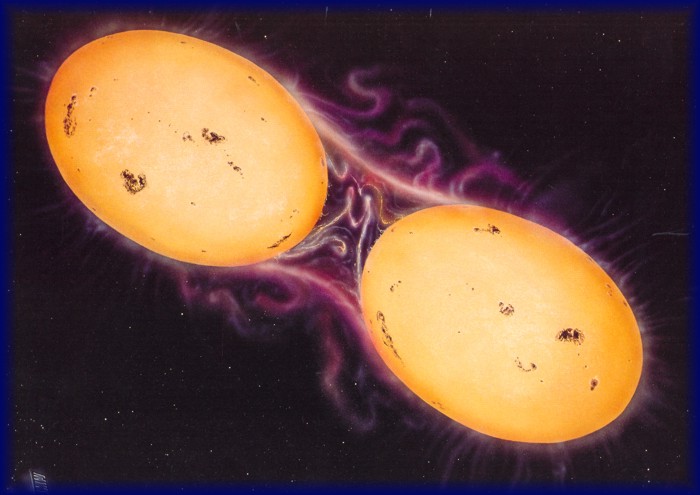|
Who's stealing the giant star's twinkle?
It was the year 1638. A revolution in understanding of the heavens had already begun with sightings of supernovae in 1572 and 1604; observations by Johannes Holwarda in this year were about to spur the revolution on with a fury. Until the 1572 supernova observation, in which a "star" seemed to appear out of nowhere, western astronomers believed that the universe we see today is exactly as it was at the moment of creation. Stars had been in every way "fixed" at creation, doomed to remain static and well-behaved until God would fold them all up at the end of time. Holwarda observed that the star Omicron Ceti pulsated over a period of eleven months in a never-ending cycle of dimming and brightening.
Since then, astronomers have observed many such "variable stars", and have classified them into two groups based on the cause of the variableness. Intrinsic variable stars are loners whose luminosity actually changes due to internal causes. Extrinsic variable stars, by contrast, only appear to brighten and dim, the dimming being due to something blocking their light along our line of sight for a period of time. The most common cause of dimming is the presence of a dark companion star that periodically blocks the brighter, primary star - to one degree or another - from our earth-bound point of view; these systems have been dubbed "eclipsing binaries".
You see, upwards of 50% of all stars (and 90% of main sequence stars) occur as binaries; that is, what appears to our eyes as one star is in fact a pair or more of stars rotating around a common center of gravity analogous to a pair of ice-skaters spinning around holding each others' hands. (See artist's impression of one such binary below.) The laws of probability are such that a small percentage of such pairs fulfil two conditions that lead to the creation of an eclipsing binary - they rotate on the same plane as the earth's and one is much darker than the other. Why so many binaries? "Just how binaries come into being remains unclear", say astronomers (Sky & Telescope, August, 1996, p. 14). Unless astronomers figure it out first, the Supremely Intelligent Designer one day will divulge the whys and hows. Oh, the joys that await us in the kingdom of God!
It should come as no surprise to learn that variables vary. Astronomers have had heaps of fun unravelling the genius of the Divine Mind shown in the myriad of variations on the same theme. One such binary, Epsilon Aurigae, has proved particularly resistant to explanation. Though astrophysicists now believe they are on the right track, numerous puzzles
|
remain; for all they know, they may be forced over the next year or more to go back to square one.
The variable nature of Epsilon Aurigae (EA for short) was probably first noticed in 1821 by Johann Fritsch. Standard techniques have yielded some basic facts about the system: it is located about 2000 light years away; the visible star's diameter is an incredible 300 times greater than the sun's; at 27.1 years between dimming events, "the length of the cycle is the longest orbital period known among eclipsing binaries". 1 The last eclipse peaked in 1983, and the next round is beginning right now as I write in September, 2009. As you have no doubt figured, they (you know - those star-gazer types) hope to solve the mysteries once and for all this time around.
Diligent observations have uncovered some seriously eccentric stuff on EA's part. First cab off the discovery rank was the protracted nature of the eclipse - the cycle of dimming and brightening takes almost two years, with up to half of EA's light being "stolen" for eleven months! 2 Stop and think. If the dimming is due to a dark object passing in front (from our perspective) of a brighter one, how huge must the dark companion be to block light for almost two years! Most intriguingly, right around the "midnight" of the dimmest part of the cycle, a short period of brightening occurs, suggesting the eclipsing object has a hole in the middle! 3 Not surprisingly, "the identity of the eclipsing object remains the great mystery of Epsilon Aurigae".4
Furthermore, careful records taken during each eclipsing event since 1874 have revealed a remarkable result, one that baffles the best brains. The gigantic, mysterious eclipsing object is changing in dramatic ways almost right before their very eyes. The length of the eclipsing period is shortening rapidly, dropping from its 1874 length of about 730 days by a total of about 44 days! 5 For astronomic phenomena, which play out over millions and billions of years, that's virtually unprecedented. And the plot thickens. While the event shrinks in total duration, the period of greatest darkness is getting longer! Last but not least, the midnight brightening is growing in prominence. Mystery wrapped in enigma.
Ah, the marvels and mysteries of space. God may be tucked away in heaven, hidden from our view, but the heavens make His incomprehensible power and ingenuity more visible than any other window does. Stay tuned. We're not going to forget Epsilon Aurigae.
|
|
1Margherita Hack, Epsilon Aurigae , Scientific American, October, 1984, p. 92
2 Hack, p. 92
3 Robert Stencel, The Very Long Mystery of Epsilon Aurigae, Australian Sky & Telescope, August/September, 2009, p. 62.
4 Hack, p. 92
5 Stencel, p. 62

Ten million years from now, the stars of ER Vulpeculae will have almost spiraled into one another (Astronomy, July, 1993)
|